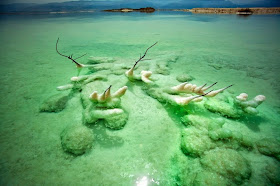General Information
Floating in the Dead Sea
How far does one have to descend to reach the Dead Sea? About 400 meters below sea level. How deep is this salty lake? Almost the same (in the northern section). Fascinating? Absolutely! Every detail about the Dead Sea is fascinating.
Here are a few more facts: The Dead Sea is the lowest point on earth in any land mass (417 meters below sea level, to be exact). The quantity of water that evaporates from it is greater than that which flows into it, such that this body of water has the highest concentration of salt in the world (340 grams per liter of water).
It is called the Dead Sea because its salinity prevents the existence of any life forms in the lake. That same salt, on the other hand, provides tremendous relief to the many ailing visitors who come here on a regular basis to benefit from its healing properties. All these and more make the Dead Sea so fascinating, so different and so interesting.
ographic Regions > The Dead Sea
Sea of Galilee (Lake Kineret)
The Carmel Mountain
Jezreel Valley
The Golan Heights
The Hula Valley
Valley of Elah
The Jordan Valley
The Galilee
The Dan Region (Gush Dan)
The Dead Sea
The Uvda Valley and Eilat Mountains
The Judean Desert
The Lowlands
The Jerusalem Hills
Gush Etzion
The Negev Desert
The Coastal Plain.
The Healing Power of the Dead Sea
Covered in Dead Sea mud
The Dead Sea can also be called “the lowest health spa in the world.” Sea salts are produced from the southern section for industry, and in the northern section promote tourism and good health. The composition of the salts and minerals in the water are what make it so unique and beneficial for the body.
The sea bed also has deposits of black mud that is easy to spread on the body and provides the skin with nourishing minerals. As if that were not enough, the bromide in the air is also beneficial to the body’s systems, thus making the Dead Sea a provider for good health and healing for vacationers from all over the world.
The Dead Sea can also be called “the lowest health spa in the world.” Sea salts are produced from the southern section for industry, and in the northern section promote tourism and good health. The composition of the salts and minerals in the water are what make it so unique and beneficial for the body.
The sea bed also has deposits of black mud that is easy to spread on the body and provides the skin with nourishing minerals. As if that were not enough, the bromide in the air is also beneficial to the body’s systems, thus making the Dead Sea a provider for good health and healing for vacationers from all over the world.
Dead Sea
Also known as Bahr Lut, Eastern Sea, Lake of Asphalt, Salt Sea, “Sea of Sodom and Gomorrah,” Sea of the Arabah, Sea of the Devil, “Sea of the Plain,” Sea of Zoar, Stinking Lake
Dead Sea sunrise
Names of the Sea
Known in the Bible as the "Salt Sea" or the "Sea of the Arabah," this inland body of water is appropriately named because its high mineral content allows nothing to live in its waters. Other post-biblical names for the Dead Sea include the "Sea of Sodom," the "Sea of Lot," the "Sea of Asphalt" and the "Stinking Sea." In the Crusader period, it was sometimes called the "Devil's Sea." All of these names reflect something of the nature of this lake.
Biblical Period
The Dead Sea, unlike the Sea of Galilee to the north, does not figure prominently in the biblical narratives. Its most important role was as a barrier, blocking traffic to Judah from the east. An advancing army of Ammonites and Moabites apparently crossed a shallow part of the Dead Sea on their way to attack King Jehoshaphat (2 Chr 20). Ezekiel has prophesied that one day the Dead Sea will be fresh water and fishermen will spread their nets along the shore.
Dead Sea lisan aerial from west
Dead Sea lowest point on earth
Lowest Point
The Dead Sea is located in the Syro-African Rift, a 4000-mile fault line in the earth's crust. The lowest point of dry land on earth is the shoreline of the Dead Sea at 1300 feet below sea level. That the lake is at the lowest point means that water does not drain from this lake. Daily 7 million tons of water evaporate but the minerals remain, causing the salt content to increase. Figures for the Dead Sea's salinity today range from 26-35%.
Mineral-Rich
Nearly ten times as salty as the world's oceans and twice as saline as the Great Salt Lake in Utah, the Dead Sea is rich with minerals. The Dead Sea Works company on the southwest side of the lake employs 1600 people around the clock to harvest the valuable minerals from the water. Potash is the most valuable of those extracted today and is used in the manufacture of fertilizer. The best article on the minerals in the Dead Sea is in the Encyclopedia Britannica.
Dead Sea shoreline with salt crystals
Man floating in Dead Sea reading newspaper
Healthy Water
The unique concentration of the Dead Sea waters has long been known to have medicinal value. Aristotle, Queen of Sheba, King Solomon and Cleopatra were all familiar with this and modern doctors as well often prescribe patients with skin ailments to soak in the waters of the Dead Sea. Because of the dropping level of the Dead Sea, the southern end is no longer under water, except for that which is channeled by aqueducts for the purpose of extracting minerals.




No comments:
Post a Comment
Don't Abuse